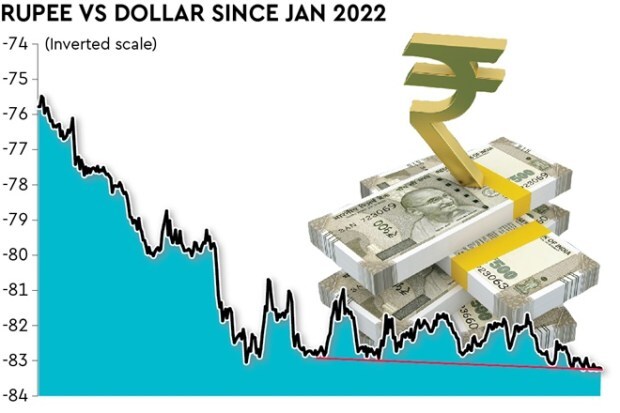Since the start of this year, the rupee has been amazingly calm—indeed, USD-INR volatility is at the lowest level we have seen in nearly 20 years. Kudos to RBI which has not wavered from its commitment to prevent substantial rupee weakness, despite the increasing noise—at least one article a week—on the need for a (much) weaker rupee to boost exports.
This effort is all the more impressive given the fact that global markets are increasingly edgy. Most people agree that while the Fed is unlikely to raise rates materially going forward, it is near-certain to keep rates on hold at these “high” levels for some time.
This is why equity markets in the US have been falling steadily since August this year. The Dow peaked on August 1 at 35,631 (a touch below its all-time high set in December 2021) right after the July 26 Fed meeting, when it hiked the funds rate to 5.25-5.5% and warned that it was not done.
At its September meeting, the Fed held rates at this level but reiterated that it may have to keep rates “high” for a much longer time than the market anticipated.
The Dow has lost nearly 10% from its peak and, despite the market’s knee-jerk upwards after the surprisingly strong employment numbers on Friday, it looks extremely nervous.
The weekend attack by Hamas on Israel opens up another very significant window of geopolitical uncertainty, all the more so given the sensitivity of the price of oil to the region. Markets certainly don’t like that.
Then, there is the issue with the US government deficit, which has increased by 61% since last year. This means there will be more and more government bonds for sale, particularly given the fact that the Fed’s quantitative tightening (QT) process remains in place where it will simply let bonds it holds lapse at maturity—this means the federal government will need to raise that much more from the market.
Increased supply means lower prices, which means higher rates. Added to this difficult situation is the currently insane politics in the US, which may yet deliver a serious budgetary crisis. All of this is certainly not conducive to a comfortable equity market.
But, perhaps most important issue is the reality that with US interest rates much higher than they have been for decades, there is little doubt that over time more and more “people swimming naked” will come into view. There’s no telling when or where the traumas will show.
An early example was Silicon Valley Bank, which the regulators managed to contain very quickly, but it is extremely likely that some (or many) more companies and/or institutions that borrowed the free money that was available seemingly forever may not have hedged their interest rate risk—after all, for a couple of decades, the Fed was underwriting the risk. Now, depending on how long the period of high rates prevails, it is possible that some of these may turn out to be systemically important.
The only calming factor (to me) is that there are more and more very well-considered analysts who are calling an upcoming crisis. Some are comparing the situation with 1987 (THE Wall Street crash) for this (and the previous) generation; some are saying the equity markets may fall by 50%; some are pointing to the fact that the collapse in long bond prices is “more than double the next biggest slump in 1981,..[it] also surpassed the 39% average loss in seven US equity bear markets since 1970, including last year’s 25% slump in the S&P 500 when the Fed started to lift rates from near zero.”

If there’s one thing we all know, it is that nobody can call the market and when so many big names climb onto the same bandwagon, there’s a reasonable chance that things won’t pan out the way they expect.
Of course, there’s no denying that uncertainty is increasing all around—the VIX (reflecting risk on the S&P 500) has shot up to 19.5 from a low of 13.8 just two weeks ago; and the volatility of DXY, which had been declining since the start of the year, has started showing a slight uptick, often a precursor for a sharp change.
With US interest rates likely to remain high but not rise much further, I feel that the dollar’s rise since July is exhausting itself, and I’d look for DXY to trend back towards 100, and possibly lower. This would make RBI’s job of keeping the rupee on a low volatility keel that much easier.
The writer is CEO, Mecklai Financial
http://www.mecklai.com
